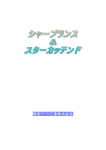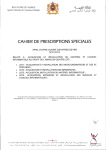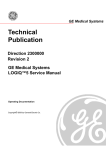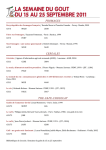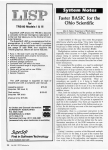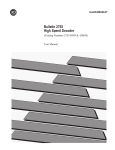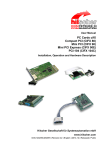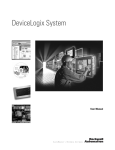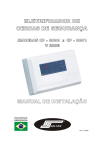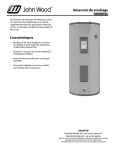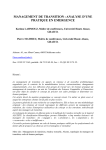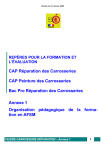Download "user manual"
Transcript
ALLEN-BRADLEY Bulletin 2755 Industrial Medium and High-Spped Bar Code Scanners (Catalog Numbers 2755-L7SA, -L7RA, -L7SB, -L7RB, -L7SC, -L7SD, -L7RD, -L9SA, -L9RA, -L9SB, -L9RB, -L9SD, -L9RD) User Manual Important User Information Solid state equipment has operational characteristics differing from those of electromechanical equipment. “Safety Guidelines for the Application, Installation and Maintenance of Solid State Controls” (Publication SGI-1.1) describes some important differences between solid state equipment and hard–wired electromechanical devices. Because of this difference, and also because of the wide variety of uses for solid state equipment, all persons responsible for applying this equipment must satisfy themselves that each intended application of this equipment is acceptable. In no event will the Allen-Bradley Company be responsible or liable for indirect or consequential damages resulting from the use or application of this equipment. The examples and diagrams in this manual are included solely for illustrative purposes. Because of the many variables and requirements associated with any particular installation, the Allen-Bradley Company cannot assume responsibility or liability for actual use based on the examples and diagrams. No patent liability is assumed by Allen-Bradley Company with respect to use of information, circuits, equipment, or software described in this manual. Reproduction of the contents of this manual, in whole or in part, without written permission of the Allen-Bradley Company is prohibited. Throughout this manual we use notes to make you aware of safety considerations. ! ATTENTION: Identifies information about practices or circumstances that can lead to personal injury or death, property damage, or economic loss. Attentions help you: • • • identify a hazard avoid the hazard recognize the consequences Important: Identifies information that is especially important for successful application and understanding of the product. PLC is a registered trademark of Allen-Bradley Company, Inc. Pyramid Integrator, DTL and CVIM are trademarks of Allen-Bradley Company, Inc. MicroVAX, VAX and DECnet are registered trademarks of Digital Equipment Corporation. VAXstation, VAXcluster and DECwindows are trademarks of Digital Equipment Corporation. Table of Contents A–B Using This Chapter Chapter 1 Chapter Objectives Overview of This Manual Intended Audience Warnings and Cautions Danger and Caution Labels Product Descriptions Chapter 2 Chapter Objectives Overview L7 Reading Ranges L9 Reading Ranges Features Cabling Accessories Installation Considerations 2–1 2–1 2–2 2–3 2–4 2–5 2–6 Chapter 3 Chapter Objectives How the Scan Head Operates Positioning the Symbols Correctly Usable Beam Length Compensating for Pitched Symbols Minimum Bar Width Adjustment Code Element Distance Installation 1–1 1–1 1–2 1–2 1–3 3–1 3–1 3–2 3–5 3–6 3–6 3–8 Chapter 4 Chapter Objectives Warnings and Cautions Before You Start Tools You Will Need Determining the Space Requirements Mounting the Scan Head Vibration Cautions How to Install Swivel Mounting Base Using the Flat Mounting Plate Connecting Your Equipment Installing the Package Detector Assembly 4–1 4–1 4–1 4–1 4–2 4–2 4–3 4–3 4–4 4–5 4–6 i Table of Contents Operation Chapter 5 Chapter Objectives Warnings and Cautions Laser On/Off Control Scan Width Adjustment Scan Width Adjustment Procedure Raster Height Adjustment Raster Height Adjustment Procedure Maintenance and Troubleshooting Chapter 6 Specifications Chapter 7 Chapter Objectives Maintaining the Equipment Scan Window Removal Cleaning the Glass Window Cleaning the Plastic Window Troubleshooting the System Scan Head 5–1 5–1 5–1 5–2 5–2 5–3 5–4 6–1 6–1 6–1 6–2 6–3 6–4 7–1 Glossary . . . . . . . . . . . . . . . . . . . . . . . . . . . . . . . . . . . . . . . . . . . . . . . . . . G–1 Index . . . . . . . . . . . . . . . . . . . . . . . . . . . . . . . . . . . . . . . . . . . . . . . . . . . . . . I–1 ii Chapter A–B 1 Using This Manual Chapter Objectives Read this chapter to familiarize yourself with the rest of the manual. You will learn about: • • • Overview Of This Manual Contents of the manual. Intended audience. Warnings and cautions. This manual is for Catalog Nos. 2755–L7SA, –L7SB, –L7SC, –L7SD, –L7RA, –L7RB, –L7RC, –L7RD Industrial Medium–Speed Bar Code Scanners and Catalog Nos. 2755–L9SA, –L9SB, –L9SD, –L9RA, –L9RB, and –L9RD Industrial High–Speed Bar Code Scanners. Chapter Title Purpose 1 Using This Manual Provides an overview of the manual. 2 Product Description Features and capabilities are described. 3 Installation Considerations Things you should know and understand before installing your scanner. 4 Installation Installation procedures. 5 Operation Operating procedures and beam adjustments. 6 Maintenance and Troubleshooting Maintenance and Troubleshooting guidelines are provided. 7 Specifications - Glossary - Index Electrical, mechanical, environmental and operational information is listed. 1–1 Chapter 1 Using this Manual Intended Audience No special knowledge is needed to read this manual and follow its directions. If the system will be used to communicate with a higher level controller, we assume you are familiar with communication terminology. Warnings And Cautions Both warnings and cautions are found in this manual and on the equipment. The following symbols are used: CAUTION: This laser caution symbol appears where laser radiation is present. WARNING: A warning symbol means people might be injured if the procedures are not followed. CAUTION: A caution symbol is used when machinery could be damaged if the procedures are not followed. Danger and Caution Labels The scan head is labeled in accordance with federal regulations. If any label is removed, lost, or becomes illegible, order a replacement from your Allen–Bradley representative. Figure 1.1 shows location of the labels on the scan head. ! WARNING: No user maintenance of the scan head is required. Do not open the enclosure! WARNING: Improperly controlling, adjusting, or operating the scan head can result in hazardous radiation exposure. 1–2 Chapter 1 Using this Manual Figure 1.1 Location of Warning and Caution Labels on the Scan Head 1–3 Chapter A–B 2 Product Description Chapter Objectives The capabilities of the scan head are described when connected to a Catalog No. 2755–DM9 Decoder. Overview The Industrial Medium and High Speed Bar Code Scanners are moving beam, bar code scan heads designed for use with the Catalog No. 2755–DM9 Decoder. The scanners are available as shown: • • Side scanning (Catalog No. 2755–L7Sx①, –L9Sx①) Side Raster scanning (Catalog No. 2755–L7Rx①, –L9Rx①) ① The x stands for the different range selections of each scanner. Refer to Figures 2.2 and 2.3. Scanning is bidirectional at approximately 350 scans per second with an L7, Industrial Medium–Speed Bar Code Scanner and 800 scans per second with an L9, Industrial High–Speed Bar Code Scanner. Depending on the scanner used, symbols can be scanned as near as 3.5 inches (8.9 cm) and as far as 50 inches (127 cm) away. Figure 2.1 Side Scanning and Raster Scanning 90–105–9 The side scanning model reflects the scanning beam out of the side of the NEMA 4 case. The raster scanning model uses a stepping raster motor to project what appears to be a number of parallel beams out the side of the unit. This type of scan head is useful when attempting to scan poor quality labels, or labels that may not always be in exactly the same place. 2–1 Chapter 2 Product Description L7 Reading Ranges Figure 2.2 illustrates the average reading ranges, relative to the symbol’s minimum bar width, that you should expect when using an L7 scanner with your Catalog No. 2755–DM9 Decoder. Figure 2.2 Average Scan Range vs. Minimum Bar Width for L7 Scanner Minimum Bar Width Mils 50 Millimeters 1.27 45 1.14 40 1.02 35 .89 30 .76 25 .64 2755–L7SC 2755–L7RC 20 .51 15 .38 2755–L7SD 2755–L7RD 10 .25 2755–L7SB 2755–L7RB 5 .13 2755–L7SA 2755–L7RA Inches 5 Centimeters12.7 10 25.4 15 20 25 30 35 40 45 50 38.1 50.8 63.5 76.2 88.9 101.6 114.3 127.0 Scan Range (from face of scanner)① ° ° ① Scan Range will vary with symbol quality, pitch and skew. This application was based on no more than 5 pitch and 30 skew, with full scan beam (Figure 5.3). Refer to Chapter 3, Installation Considerations when reading labels with more than 20 pitch. ° The following table compares the minimum bar width to the scan range of each catalog number. Minimum Bar Width Scan Range① Catalog Number Mils mm Inches Centimeters Side Scanning Raster Scanning 7.5 10 20 .19 .25 .51 6.5 – 8.5 6.0 – 9.0 5.0 – 11.0 16.5 – 21.6 15.2 – 22.9 12.7 – 27.9 2755–L7SA① 2755–L7RA① 11 20 25 .28 .51 .64 8.5 – 13.5 5.5 – 19.0 3.5 – 22.0 21.6 – 34.3 14.0 – 48.3 8.9 – 55.9 2755–L7SB 2755–L7RB 16 25 35 .41 .64 .89 10 – 23 8 – 29 6 – 35 25.4 – 58.4 20.3 – 73.7 15.2 – 88.9 2755–L7SD 2755–L7RD 20 35 50 .51 .89 1.27 16 – 35 8 – 50 8 – 50 40.6 – 88.9 20.3 – 127 20.3 – 127 2755–L7SC 2755–L7RC ① When using ‘‘A’’ range scanners to read labels with high paper noise, increasing the skew to 25 will enhance performance. 2–2 Chapter 2 Product Description L9 Reading Ranges Figure 2.3 illustrates the average reading ranges, relative to the symbol’s minimum bar width, that you should expect when using an L9 scanner with your Catalog No. 2755–DM9 Decoder. Figure 2.3 Average Scan Range vs. Minimum Bar Width for L9 Scanner Minimum Bar Width Mils 35 Millimeters .89 30 .76 25 .64 20 .51 2755–L9SD 2755–L9RD 15 .38 10 .25 2755–L9SB 2755–L9RB 2755–L9SA 2755–L9RA 5 .13 10 25.4 Inches 5 Centimeters 12.7 15 38.1 20 50.8 25 63.5 30 76.2 35 88.9 Scan Range (from face of scanner) ① ① Scan Range will vary with symbol quality, pitch and skew. This application was based on no more than 5°pitch and 30° skew, with full scan beam (Figure 5.3). Refer to Chapter 3, Installation Considerations when reading labels with more than 20° pitch. The following compares the minimum bar width to the scan range of each catalog number. Minimum Bar Width Scan Range② Catalog Number Mils mm Inches Centimeters Side Scanning Raster Scanning 7.5 10 20 .19 .25 .51 6.5 – 8.5 6.0 – 9.0 5.0 – 11.0 16.5 – 21.6 15.2 – 22.9 12.7 – 27.9 2755–L9SA① 2755–L9RA① 11 20 25 .28 .51 .64 10 – 13.5 9 – 16 8.5 – 18 25.4 – 34.3 22.9 – 40.6 21.6 – 45.7 2755–L9SB 2755–L9RB 16 25 35 .41 .64 .89 10.5 – 21.5 9.0 – 25.5 7.5 – 30③ 26.7 – 54.6 22.9 – 64.8 19.1 – 76.2③ 2755–L9SD 2755–L9RD ② Scan range will vary with symbol quality. This application was based on no more than 5° pitch and 30° skew with full scan beam (Figure 5.3). Refer to Chapter 3, Installation Considerations when reading labels with more than 20° pitch. ③ Scan range may be reduced when using low contrast labels. 2–3 Chapter 2 Product Description Features Laser Shut Off – Use this switch to enable/disable the laser beam without interrupting power. The upward position (ON) enables the laser, the downward position (OFF) disables the laser beam. The use of this feature is covered in Chapter 5, Operation. LED indicators – There are two LEDs on the back of the scan head, Power On and Valid Read. They are defined in Figure 2.4. Figure 2.4 Scan Head Features NEMA 4 Case – Both the L7 and L9 scan heads are housed in gasketed, NEMA 4, aluminum cases. Replaceable Scan Windows – You can easily remove and replace the scan windows. Both the L7 and L9 scan heads are shipped with coated, optical quality, glass windows. Coated, low loss, optical quality, plastic windows are also available for special applications, or when required by FDA regulations. The use of this feature is covered in Chapter 6, Maintenance and Troubleshooting. Package Detector Port – Connect the optional Package Detector Assembly (Catalog No. 2755–NP3, or NP5) to this port to allow the scan head to be turned on only when there is a package present. The use of this feature is covered in Chapter 4, Installation. Scan Width Adjustment – This four position switch is located behind a gasketed 1/4–20 screw. Rotate this switch, using the supplied tool, to set the scan width to one of four settings: full, , , . Examples of this feature are covered in Chapter 5, Operation. Raster Height Adjustment – This four position switch is located behind a gasketed 1/4–20 screw. Rotate this four position switch to increase/decrease the height of your raster scanning pattern (on L7R and L9R only). Examples of this feature are covered in Chapter 5, Operation. 2–4 Chapter 2 Product Description Figure 2.5 Scan Head Features Cabling Scanner to Decoder cables are sold separately. Refer to Table 2.C for information necessary to order the proper cable. Accessories Several accessories are available to provide installation and operational flexibility, including: • • • Package Detector Assembly – This assembly consists of a Package Detector Switch and a reflector. This switch indicates to the decoder that a package is present. Mounting hardware – A swivel ball mounting base is available for use with a flat mounting plate or “T” Mounting plate. Replaceable Windows – Replaceable, optical quality, glass and plastic windows are available. 2–5 Chapter 2 Product Description The following table lists system accessories. Catalog Number Item Description 2755–NP3 Long Range Package Detector Assembly An infrared photoelectric switch and reflector. For the detection of packages up to a maximum of 18 feet (5.5 m) away. 2755–NP5 Short Range Package Detector Assembly A visible red photoelectric switch and reflector. For the detection of packages up to a maximum 10 feet (3 m) away. 2755–NC9 Package Detector Port Connector Connects user–supplied photoelectric switch to scan head. Accepts cables with .190 to .312 inches (4.8 to 7.9 mm) outer jacket diameter. 2755–NM1 Swivel Mounting Base 2755–NM2 “T” Mounting Plate Mounts Swivel Mounting Base (Catalog No. 2755–NM1) to scan head. 2755–NM3 Flat Mounting Plate Attach this plate to scan head in order to use your own brackets, or to use the Swivel Mounting Base (Catalog No. 2755–NM1) when you want the swivel ball close to the base of the scan head. 2755–CL10 10 foot (3 meter) Cable Connects scanner to Catalog No. 2755–DM9 Decoder. 2755–CL25 25 foot (7.6 meter) Cable Connects scanner to Catalog No. 2755–DM9 Decoder. Universal swivel ball mount for greater installation flexibility. Must be used with “T” Mounting Plate or Flat Mounting Plate. W77121–800–01① Replacement Glass Window Kit Anti–reflective, optical glass replacement window. W77121–800–02① Replacement Plastic Window Kit Hard coated, anti–reflective, optical quality, plastic replacement window. W77121–802–01① Caution & Warning Label Kit (English Only) 2755–L7, L9 - 5 sets per package. W77121–802–02① Caution & Warning Label Kit (Alternate Language) 2755–L7, L9 - 1 set each in German, French, Italian, Spanish. ① Replacement part number. 2–6 Chapter A–B 3 Installation Considerations Chapter Objectives The operation of the scan head is briefly described. In addition, the importance of proper symbol positioning and the effect pitch has upon a symbol is also discussed. How thw Scan Head Operates Inside the scan head is the laser, the lens and mirror system and the electronics. The laser generates a small, concentrated light beam that is focused and projected through a window. This light is reflected by a symbol and returned to the scan head for processing. The signal is then sent to the decoder for further processing. Refer to Figure 3.1. Figure 3.1 How the Scan Head Operates Reflected light from symbol (Diffuse Return) To Label 3–1 Chapter 3 Installation Considerations Positioning the Symbols Correctly As the symbols move past the scan head, they must be correctly oriented. The laser’s line of light must cut through all the bars and spaces in one sweep. Laser’s line of light cuts through the entire symbol For example, if the scan head is mounted so the laser beam is in the vertical direction, then the symbol must also be mounted vertically, commonly known as the step ladder orientation. Figure 3.2 illustrates the step ladder orientation. Figure 3.2 Step Ladder Orientation Label Conveyor Direction If the scan head is mounted so the beam is in the horizontal direction, the symbol must also be in the horizontal direction. This is termed picket fence orientation. Refer to Figure 3.3 for an example of the scan head and symbol in a picket fence orientation. Figure 3.3 Picket Fence Orientation Label Conveyor Direction 3–2 Chapter 3 Installation Considerations When setting up your scanner, you should attempt to have the laser line of light nearly perpendicular to the bars and spaces of the symbol. For optimal performance mount the scan head in a skewed position, 10° to 20° angle off normal from the symbol, as shown in Figure 3.4. Figure 3.4 Proper Mounting of Scan Head Symbol 20° 10° Optimal angles for scanning 10° beam 20° 90° 20° 90° 10° 10° 20° Optimal angles for scanning beam The scan head can successfully decode symbols that are out of alignment, provided that the projected, or apparent, bar element widths are within the minimum widths shown in Tables 2.A and 2.B. Symbols that are pitched or tilted up to ±45°, are still readable. Skewed symbols can also be read as long as the misalignment is less than ±50°. Figure 3.5 shows a correctly placed symbol as well as misaligned symbols. Note: When using “A” range scanners to read labels with high paper noise, increasing the skew to 25° will enhance performance. ! WARNING: If at any time during operation an intense dot of light is reflected onto a symbol instead of a line of light, turn the scanner OFF with the toggle switch on the back of the scanner. Then turn the decoder OFF. 3–3 Chapter 3 Installation Considerations Figure 3.5 Positioning Terminology Skewed package and symbol Pitched package and symbol Tilted, over square symbol Correctly positioned symbol and package When setting up a raster scanner, the raster pattern can either overlap the entire symbol, or be restricted to cover only a portion of the symbol. Overlapping the symbol helps to aid in the scanning of misaligned symbols. Restricting, or dithering the raster pattern is helpful when scanning symbols of poor quality. Refer to Figure 3.6. Figure 3.6 Raster pattern 3–4 Chapter 3 Installation Considerations Usable Beam Length Figure 3.7 shows the size and shape of the scanning window. The black area is a no read are area. The Usable Beam Length (bottom of chart) is compared to the the Reading Distance (top of chart). The Usable Beam Length is slightly less than the projected beam length. The reading distance is measured from the scan window to the center of the symbol. Figure 7 Usable Beam Length Inches 0 0 Centimeters L7 Reading Distance① 5 12.7 10 25.4 15 38.1 20 50.8 25 63.5 30 76.2 35 88.9 40 101.6 45 114.3 50 127.0 Usable Beam Length Reading Distance To estimate the Usable Beam Width: 1. Determine the distance from the face of the scanner to the center of the bar code symbol. This distance is your Reading Distance. 2. Locate your Reading Distance on the L7 or L9 diagram (the Reading Distances are displayed across the top of each scale). 3. Displayed across the bottom of each scale are the nominal Usable Beam Lengths. Inches NA NA Centimeters 5.2 13.2 8.7 22.1 12.2 31.0 15.6 39.6 19.1 48.5 22.6 57.4 26.1 66.3 29.6 75.2 33.0 83.8 36.5 92.7 Usable Beam Length (nominal) L9 Reading Distance① Inches Centimeters 0 0 5 12.7 10 25.4 15 38.1 20 50.8 25 63.5 Usable Beam Length Reading Distance Inches Centimeters NA NA 2.9 7.4 4.8 12.2 6.7 17.0 8.6 21.8 30 76.2 10.6 26.9 12.5 31.8 Usable Beam Length (nominal) ① Measured from the face of the scanner to the center of bar code symbol. 3–5 Chapter 3 Installation Considerations Compensating for Pitched Symbols When attempting to read a symbol that is pitched, two things must be considered: • • The adjusted minimum bar width The nearest and farthest code elements must be within the scanners reading range Minimum Bar with Adjustment When a symbol is pitched, the bars appear to be narrowerand closer to one another. This apparent element width is a reduction of the actual element width. Before you attempt to position your scanner using Figures 2.2 and 2.3 found in Chapter 2, you must determine your symbol’s adjusted minimum bar width. Figure 3.8 shows two boxes, each having the same bar code symbol printed on them. Below each box is an exaggerated view of 5 elements (3 black, 2 white) as seen from the top down. Figure 3.8 Actual versus Apparent Element Width Apparent Element Width 18mil (.46 Actual Element Width 21 mil (.53 mm) because of 30 ° pitch, elements mm) 0° pitch appear narrower Pitched 30 ° Actual Element Widths 21 mil Actual Element Widths 21 mil 30° Apparent Element Widths 18 mil 3–6 Chapter 3 Installation Considerations For example, a 21 mil (.53mm) symbol with 0° pitch can be successfully scanned at 27 inches (68.6 cm) with a Catalog. No. 2755–L7SC scanner. If you pitch the symbol 30° and determine the adjusted minimum bar width using the formula below, you will realize that you are attempting to read an 18 mil (.46 mm) symbol. Adjusted Minimum Bar Width = Actual Bar Width * cos [pitch angle] In our example, the following conditions apply: Actual Bar Width = 21 mil (.53 mm) Pitch Angle = 30° Therefore: 21 * cos [30] = 18.2 mil (.46 mm) The minimum recommended bar width that the L7SC can read is 20 mil (.54 mm). Because of the pitch of the symbol, you will have to use a different scanner, such as the L7SD. However, you will also have to decrease the distance between the scanner and the symbol. The Catalog No. 2755–L7SD’s maximum read range with a 18 mil (.46 mm) symbol is 24 inches (61 cm). The farthest element of the symbol including the quiet zone must not exceed 24 inches (61 cm). In summary, increasing the pitch of the symbol decreases the minimum bar width. Figure 3.9 is an excerpt from Figure 2.2, which illustrates this example. Figure 3.9 Pitch Effecting Scan Range Minimum Bar Width Inches 25 Millimeters .64 21 mil (.53mm) long symbol with 0° pitch 20 .51 2755–L7SC 15 .38 2755–L7SD Symbol to scanner distance has also been compensated so symbol can be read (see next page). 2755–L7SB 10 .25 2755–L7SA 5 .13 Inches 5 Centimeters 12.7 10 25.4 15 38.1 20 50.8 21 mil (.53mm) long symbol with 30° pitch yields adjusted minimum bar width of 18 mil (.46mm). 25 63.5 30 76.2 35 88.9 Scan Range ( from scan window) 3–7 Chapter 3 Installation Considerations Code Elelment Distance The pitched symbol’s nearest and farthest elements must be within the minimum and maximum reading distance of your scanner. Centering your symbol within the scanner’s minimum and maximum scan range can help guard against pitched symbols exceeding the scan range limits. However , you could exceed the scan range with a pitched symbol, as shown in Figures 3.10 and 3.11. Figure 3.10 Scan Range and Symbol Resolution at 0° Pitch 3” (7.6 cm) long symbol pitched 0°. The center of the symbol is positioned 10” (25.4 cm) from the face of the scanner. 10 ” 3” Scan Range equals 10” (25.4cm). 2755–L7SA Symbol’s Nearest and Farthest Elements 10” Minimum Bar Width Mils 25 Millimeters .64 20 .51 2755–L7SC 15 .38 As you can see, the 2755–L7SA scanner can be effectively used for this application. 2755–L7SD 2755–L7SB 10 .25 2755–L7SA 5 .13 Inches 5 Centimeters 12.7 10 25.4 15 38.1 20 50.8 25 63.5 Scan Range (from face of scanner) 3–8 The center of the 3” (7.6 cm) long symbol, pitched 0°, is positioned 10” (25.4 cm) from the face of the scanner. 30 76.2 35 88.9 Chapter 3 Installation Considerations Figure 3.11 further illustrates how the pitched symbol changed the Scan Range enough to require a different scanner. Figure 3.11 Scan Range And Symbol Resolution Changed By Pitch 11.5 ” In this example, a 3 inch (7.6 cm) symbol pitched 30° will require the scanning beam to extend an additional 1.5 inches (3.8 cm). 10 ” 3” 2755–L7SA 1.5 ” Symbol’s Nearest Element 10” Symbol’s Farthest Element 11.5” Minimum Bar Width Mils 25 Millimeters .64 This was the the Scan Range and element width at 0° pitch. 20 .51 2755–L7SC 2755–L7SD 15 .38 This is the new Scan Range. Pitching the symbol changed the bar width and extended the scan range. 2755–L7SB 10 .25 2755–L7SA 5 .13 Inches 5 Centimeters 12.7 10 25.4 15 38.1 20 50.8 25 63.5 30 76.2 35 88.9 The L7SA scanner is not recommended for this application. Instead, use the L7SB. Scan Range (from face of scanner) A pitched symbol will always change the minimum bar width and scan range of the symbol. The amount of the change depends on the pitch of the symbol. 3–9 Chapter A–B 4 Installation Chapter Objectives Carefully read this chapter before installing the system. We list rules and recommendations for installing and connecting your scanner. Warning and Cautions • ! • WARNING: Do not make any other adjustments to the equipment than those specified in this manual. WARNING: If at any time during operation an intense dot of light is generated instead of a thin line of light,immediately turn the laser off, using the toggle switch on the back of the scanner, then remove power to the decoder. CAUTION: Do not look directly into the laser beam. It could damage your eyes. ! WARNING: No user maintenance of the hardware is required. Do not open the unit’s housing! Before You Start The angle and distance between the scan head and the label is an important consideration. These considerations, orientation and alignment, are described in Chapter 3, Installation Considerations. Tools You Will Need Normally, the only tools you will need for installation will be the adjustment tool supplied with your scanner. If the optional Swivel Mounting Base and Plate are used (Catalog No. 2755–NM1 and 2755–NM2), you will also need a screwdriver and a 3/16–inch Allen wrench. 4–1 Chapter 4 Installation Determining the Space Requirements The decoder and scan head are separate units that can be mounted in different locations. A 10 foot (3 meter) or 25 foot (7.6 meter) cable is used to connect the two units. Figure 4.1 illustrates the dimensions of the scan head. Figure 4.1 Mounting Dimensions of the Scan Head 10–32UNF–2B x .31 2.69 in 6.83 cm 5.38 in 13.67 cm 2.69 in 6.83 cm Back View 2.20 in 4.75 in 3.00 in 4.75 in 12.07 cm 7.62 cm 12.07 cm Front View 5.59 cm 3.19 in 8.05 cm 10–32UNF–2B x .31 1.357 in 3.45 cm 2.69 in 6.83 cm 1.33 in 3.38 cm 4.75 in 3.00 in 4.75 in 12.07 cm 7.62 cm 12.07 cm 12.5 in 31.75 cm Bottom View Mounting the Scan Head Before installing the scan head, review the following information: • • • • Determine the optimum position of the scan head relative to the labels that are to be read. Refer to Chapter 3 for positioning information. If you are using the optional swivel base or brackets, add their dimensions into your positioning calculations. Allow a minimum clearance of 8 inches (20.3 cm) at the rear of the scan head so you can attach the cables to the various ports. Securely mount the scan head to a rigid surface to ensure proper operation of the scanning mechanism. The thickness of your mounting surface determines the length of the screws or bolts required. You will need two 10–32 screws, with flat and split washers. Select a length that equals the thickness of the mounting surface, thickness of the washers plus the depth of the screw holes, 3/8–inch (9.5 mm). 4–2 Chapter 4 Installation Vibration Cautions The raster scanning models may occasionally experience raster rollover. This condition is caused by jarring the scanner, excessive vibration, and will occasionally occur upon power up. The stepping of the raster motor is controlled by an incremental shaft encoder, which has the ability to reset itself if one of the above conditions is met. Note: If the scanner is jarred during operation, labels may not be scanned while the raster is resetting. In high speed operations, some objects may not be scanned. 4–3 Chapter 4 Installation How to Install the Swivel Mounting Base (Catalog No. 2755-NM1 and 2755-NM2) For greater installation flexibility, you can attach the scan head to an optional Swivel Mounting Base. The installation dimensions of the Swivel Base and its associated “T” Mounting Plate are shown in Figure 4.2. Figure 4.2 Mounting Dimensions of Swivel and “T” Mounting Plate Inches (Centimeters) 3.19 (8.10) 2.812 (7.14) .19 (4.83) .30 (7.62) 2.00 (5.08) 1.500 (3.81) 1.625 (4.13) .38 (9.65) 1.88 (4.78) 1.25 (3.18) 3.000 (7.62) .180 (4.57) 4 places .187 (4.75) .75 (19.05) .25 (6.35) 1.00 (2.54) 1.50 (38.1) 5.50 (13.97) 7/16–20 UNF–2A 1.00 (2.54) 3.63 (9.22) 3.75 (9.53) 0.213 Dia. 2 Holes 7/16–20 UNF–2B 5/8 Deep .13 (3.3) Swivel Mounting Base Catalog No. 2755–NM1 4–4 “T” Mounting Plate Catalog No. 2755–NM2 Chapter 4 Installation Using the Flat Mounting Plate (Catlaog No. 2755-NM3 Series B) A Flat Mounting Plate is also available. By attaching this plate to the bottom of your scan head, you can position the swivel mounting ball close to the base of the scan head. Make sure the Allen nut on the mounting ball is tight. You may also use the Flat Mounting Plate when you want to mount the scan head with brackets of your own design. Whenever possible, mount the scanner on its wide side as shown on page 4–3. The dimensions are shown in Figure 4.3. Figure 4.3 Mounting Dimensions of the Flat Plate Inches (Centimeters) 2.25 (5.71) .25 (0.64) 1.500 (3.31) .38 (0.96) .750 (1.91) 0.204 (0.52) & Countersunk 3.000 (7.62) 3.50 (8.89) .25 (0.64) 80 2.812 (7.14) .093 (0.24) .31 (0.79) ° 0.390 (0.99) 2 Places 1.625 (4.13) 6–32 UNC–2B 4 Places Flat Mounting Plate with Mounting Screws Catalog No. 2755–NM3 Series B Connecting Your Equipment Connect your equipment using the appropriate cables. Follow the step–by–step procedure described below. Step 1 With the power to the decoder OFF, connect your scanner to the port labeled Scan Head on the back of the decoder. Step 2 Connect the configuration terminal to the decoder’s Auxiliary port. Step 3 The initial configuration should be done at this time, if it was not done earlier (refer to the User’s Manual supplied with your decoder). Step 4 If a host computer will be used, connect it to the port labeled Host on your DM9 decoder. Step 5 If output devices will be used, connect them to the decoder (refer to the User’s Manual supplied with your decoder). Step 6 If a package detector will be used, connect it to the small port on the scan head. Step 7 Refer to Chapter 5 for scanner operation. 4–5 Chapter 4 Installation Installing the Package Detector Assembly When installing the Package Detector Assembly, we recommend you observe the following guidelines: • • • Install the Package Detector Switch at an angle to the label to minimize the light reflecting off the label. Install the reflector so the Package Detector’s operating range is not exceeded. The Package Detector’s beam must be broken before the label is in position. Figure 4.4 Recommended Placement of Package Detector Switch and Reflector. Reflector① Scan Head Package Detector Switch ① The laser beam must not strike the reflector, or you may get inaccurate reads Figure 4.5 specifies which pins on the Package Detector Port Connector (Catalog No. 2755–NC9) are used. Figure 4.5 Pins Used on Package Detector Connector A B C Package Detector Input ① Common + 12V Package Detector Port ① The package detector input is used to trigger the decoder to start decoding information. The package detect LED on the Decoder will light when the package detect input is active. Note: If you have programmed the decoder to turn the laser ON only upon a package detect, the laser will be OFF until the package detector is triggered. Refer to the User’s Manual for your decoder. 4–6 Chapter A–B 5 Operation Chapter Objectives Guidelines on how to operate the scanners are described when connected to a Catalog Number 2755-DM9 Decoder. Warning and Cautions • ! • WARNING: Do not make any other adjustments to the equipment than those specified in this manual. WARNING: If at any time during operation an intense dot of light is generated instead of a thin line of light,immediately turn the laser off, using the toggle switch on the back of the scanner, then remove power to the decoder. CAUTION: Do not look directly into the laser beam. It could damage your eyes. Laser On/Off Control As shown in Figure 5.1, a toggle switch is used to enable and disable the laser beam that exits the enclosure. Figure 5.1 Laser On/Off Toggle Switch 5–1 Chapter 5 Operation Scan Width Adjustment As shown in Figure 5.2, all scan heads come equipped with a 4 position switch used for scan width adjustment. The switch is covered by a gasketed 1/4–20 screw. Figure 5.2 Scan Width Adjustment Switch To avoid an unnecessarily long beam, rotate this switch clockwise. The scan width will reduce from full to approximately 3/4, 1/2 and 1/4. Figure 5.3 shows the scan width relative to the switch position. In each case, the usable scan beam will be 80% of the actual beam width. Figure 5.3 Scan Width Adjustment Switch Positions Full scan beam 1/2 scan beam 3/4 scan beam Factory Setting 1/4 scan beam Reducing the scan width will often improve the scanner’s performance while reading UPC, Code 128 and other high density labels at short ranges. Increasing the scan width may improve the readability of low contrast labels at maximum ranges. 5–2 Chapter 5 Operation Scan Width Adjustment Procedure 1. Remove power to the scan head. In doing so, you will avoid harmful direct eye contact with the beam. 2. Remove the gasketed 1/4–20 screw to expose the scan width adjustment screw. 3. Using the adjustment tool provided with the scanner, carefully rotate the switch to the desired position. 4. Replace the gasketed 1/4–20 screw. 5. Apply power to the scan head. Raster Head Adjustment Raster scan heads are equipped with stepping raster motors designed to move in synchronization with the scan sweep. The raster motor takes one step on each reverse scan. Each step deflects the scan beam by approximately .3°. The approximate spacing between the raster lines can be expressed as: N (Lines/Inch) = 191/D D = Distance from scan head to Label. For maximum accuracy, measure from the label center to the scan window, then add 1.28 inches (3.25 cm). Figure 5.4 shows the Raster Height Adjustment Switch, which is covered by a gasketed 1/4–20 screw. Figure 5.4 Raster Height Adjustment Switch 5–3 Chapter 5 Operation This switch selects the number of steps, or increments, the raster motor makes. To reduce the number of steps, rotate this switch counterclockwise. The raster heights are shown, relative to the switch positions, in Figure 5.4. Figure 5.4 Raster Height Adjustment Switch Positions 30° Raster Sweep 8° Raster Sweep Raster Height Adjustment Procedure 15° Raster Sweep 3° Raster Sweep Factory Setting 1. Remove power to the scan head. In doing so, you will avoid harmful direct eye contact with the beam and scanner rollover (explained on page 4–3 under Vibration Cautions). 2. Remove the gasketed 1/4–20 screw to expose the Raster Height Adjustment Switch. 3. Using the adjustment tool provided with the scanner, carefully rotate the switch to the desired position. 4. Replace the gasketed 1/4–20 screw. 5. Apply power to the scan head. 5–4 Chapter A–B 6 Maintenance and Troubleshooting Chapter Objectives Maintenance procedures are stated and troubleshooting charts are provided in this chapter. Maintaining the Equipment ! Scan Window Removal WARNING: No user maintenance of the scan head is required. Do not open the enclosure. The scan window fits into an opening on the side of the scan head. A gasketed cover is then tightly secured over the window to ensure a NEMA 4 rating. To remove the scan window: 1. Remove the four Phillips head screws from the cover. 2.Lift the cover away from the scan head. Make sure the scan window does not fall out. Handle the scan window by the edges to avoid finger prints. Refer to Figure 6.1. Figure 6.1 Scan Window Removal 6–1 Chapter 6 Maintenance and Troubleshooting Cleaning the Glass Window Do not use abrasive materials, such as disposable paperwipes, to clean the glass scan window. Most disposable wipes, or paper towels, use glass fibers which will scratch and cloud the window. Instead, use the following materials: Air: Optics rated clean air Solvent: Optics rated cleaning solution for use on coated lenses Wipe: Optics quality lens cleaning paper and cotton–tipped swabs. Use the following procedure to clean the glass scan window: ! CAUTION: Do not use abrasive materials, such as disposable paper wipes, to clean the glass scan window. In most cases, they contain glass fibers that will scratch and cloud the window. Step 1 Turn the decoder OFF. Step 2 Check that the PWR ON indicators on both the decoder and scan head are OFF. Step 3 Use the lens cleaning paper to wipe any dust or foreign material from the window. Be careful not to scratch the window with any grit that might be on the window. Step 4 Dust off the scan window and adjacent areas with optics rated air. Step 5 Remove the scan window. Figure 6.1 illustrates the removal. ! CAUTION: Do not touch the internal mirrors! Smudge from finger prints will diffuse the beam. Step 6 Clean the window using the optics rated cleaning solution, cotton–tipped swabs and lens cleaning paper. To avoid smearing film and fingerprints, rotate the cotton–tipped swab, while it’s on the glass, nearly one full turn. Then, discard it. Step 7 Replace the scan window. Step 8 Turn the decoder ON. The PWR ON indicators on both the decoder and scan head should be ON. When the window is clean, you will barely be able to see the reflection of the laser beam on the clear glass. 6–2 Chapter 6 Maintenance and Troubleshooting Cleaning the Plastic Window Do not use abrasive materials, such as disposable paper wipes, to clean the plastic scan window. Most disposable wipes, or paper towels, use glass fibers which will scratch and cloud the window. Instead, use the following materials: Air: Optics rated clean air Solvent: Optics rated cleaning solution for use on coated lenses Wipe: Optics quality lens cleaning paper and cotton–tipped swabs. Use the following procedure to clean the glass scan window: ! CAUTION: Do not use organic solvents or abrasive materials, such as disposable paper wipes, to clean the plastic scan window. In most cases, they contain glass fibers that will scratch and cloud the window. Step 1 Turn the decoder OFF. Step 2 Check that the PWR ON indicators on both the decoder and scan head are OFF. Step 3 Use the lens cleaning paper to wipe any dust or foreign material from the window. Be careful not to scratch the window with any grit that might be on the window. Step 4 Dust off the scan window and adjacent areas with optics rated air. Step 5 Remove the scan window. Figure 6.1 illustrates the removal. ! CAUTION: Do not touch the internal mirrors! Smudge from finger prints will diffuse the beam. Step 6 Clean the window using the optics rated cleaning solution, cotton–tipped swabs and lens cleaning paper. To avoid smearing film and fingerprints, rotate the cotton–tipped swab, while it’s on the glass, nearly one full turn. Then, discard it. Step 7 Replace the scan window. Step 8 Turn the decoder ON. The PWR ON indicators on both the decoder and scan head should be ON. When the window is clean, you will barely be able to see the reflection of the laser beam on the clear glass. 6–3 Chapter 6 Maintenance and Troubleshooting Troubleshooting the System Problem Possible Solution Decoder is not turned ON. Turn decoder ON. Improper connection to power supply. Reconnect power cord to source. Line fuse on decoder is blown. Replace fuse on decoder. Faulty power cord or switch. Check that voltage is present at service outlet. No incoming power. Check that voltage is present at service outlet. Interconnect cable between decoder and scan head is loose. Reconnect cable and check connections. Interconnect cable is defective. Replace cable. Scan head or decoder is defective. Replace scan head. Laser ON/OFF toggle switch is in OFF position. Check Laser ON/OFF toggle switch position. No scan trigger signal. Verify sending of scan trigger by either package detect or trigger from decoder. Improperly positioned labels. Check that reading distance is correct and orientation of labels to scan head is correct. Poor quality labels. Check that labels are good quality and within specifications. Laser ON/OFF toggle switch is in OFF position. Check Laser ON/OFF toggle switch position. Decoder is improperly programmed. Refer to the appropriate User’s Manual. Loose cables or connections. Check cables and connections. Scan Window is dirty Clean window. Refer to Chapter 6 Laser beam expands and contracts. Scan head is not securely mounted. Improve mounting. Warning! Laser scanning mechanism is not operating correctly. Turn laser OFF using toggle switch on back of scanner, then turn decoder OFF. PWR ON indicators on both scan head and decoder do not light. PWR ON indicator on scan head does not light, but PWR ON indicator on decoder is lit. No laser beam emitted from window of scan head Unable to read a label. Laser beam is an intense dot of light. 6–4 Probable Cause Chapter A–B 7 Specifications Scan Head (Catalog Number 2755-L7 and L9 Electrical Receives power from decoder. Mechanical 10–32UNF–2B x .31 Enclosure Cast aluminum NEMA 4 LED Indicators Power On Valid Read Weight 6.5 lbs. (2.95 kg) Dimensions (H x W x D) 5.38” x 12.5” x 2.69” 2.69 in 6.83 cm 5.38 in 13.67 cm 2.69 in 6.83 cm Back View 2.20 in 4.75 in 3.00 in 4.75 in 12.07 cm 7.62 cm 12.07 cm Front View 5.59 cm 3.19 in 8.05 cm 10–32UNF–2B x .31 1.357 in 3.45 cm 2.69 in 6.83 cm 1.33 in 3.38 cm 4.75 in 3.00 in 4.75 in 12.07 cm 7.62 cm 12.07 cm 12.5 in 31.75 cm Bottom View Environment CDRH Standards Ambient temperature range, 32° to 131°F (0° to 55°C) Meets Class II standards 7–1 Chapter 7 Specifications Optical Light Source Power Focused helium–neon (He–Ne) laser (632.8nm) 1.5 mW max. Fixed Scan Rate L7 – 350 scans/second, ± 5% L9 – 800 scans/second, ± 5% Scan sweep angle L7 47° L9 27° Scan Range L7 3.5” to 50” (8.89 cm to 127 cm) from scan window. ① L9 5” to 30” (12.7 cm to 76.2 cm) from scan window ① Depth of Field L7 3.5” to 50” (8.89 cm to 127 cm) from scan window ① L9 5” to 30” (12.7 cm to 76.2 cm) from scan window ① Label Skew L7 5° to 50° from normal ② L9 5° to 50° from normal ② Label Pitch L7 5° to 45° from normal ② L9 5° to 45° from normal ② Package Detect Min. OFF–State Voltage 11 VDC Max. ON–State Voltage 2 VDC ① ② 7–2 Depending on the model selected Depending on label quality Glossary A–B G A AIM Acronym for Automatic Identification Manufacturers. alignment The relative position of a scanner or light source to the target or the receiving element. alphanumeric or alphameric The character set which contains letters, digits, and other characters such as punctuation marks. aspect ratio The ratio of height to width of a bar code symbol. A code twice as high as wide would have an aspect ratio of 2; a code twice as wide as high would have an aspect ratio of or 0.5. attended system A scanner/decoder combination that must be activated, or attended, by an operator. average background reflectance Expressed as a percent, this is the simple arithmetic average of the background reflection reading from at least five different points on a sheet. average edge An imaginary line bisecting the irregularities of the character edge. B background The area surrounding a printed symbol. bar The dark element of a printed symbol. bar code The vertical bars and spaces found in a bar code symbol. bar code density The number of characters which can be represented in a lineal inch. bar code label A label that carries a bar code and is suitable to be affixed to an article. bar code reader A device used to identify and read a bar code symbol. Also know as a decoder bar code symbol A group of vertical bars ,that represents a character or group of characters whose spacing is determined by a specific set of rules. In most cases, human readable characters are also printed below the bars. G–1 Glossary bar length The bar dimension perpendicular to the bar width. bar width The thickness of a bar measured from the edge closest to the symbol’s start character to the trailing edge of the same bar. bidirectional symbol A bar code symbol that can be read in complementary (two) directions. binary code A power–of–two code; each bit position has a weighted value. bit An acronym for Binary Digit. The smallest unit of information in the binary numbering system. Represented by the digits 0 and 1. C CCD Acronym for Charge Couple Device; a linear image sensor that scans at high speeds (approximately 4,000 times per second) and detects the presence or absence of marks passing under the device. character A single group of bars and spaces representing an individual number, letter or punctuation mark. A graphic shape representing a letter, number or symbol. character alignment The vertical or horizontal position of characters with respect to a given reference line. character density The dimension, in linear inches, required to encode one character. character reading Reading of alpha or numeric characters,and/or symbols, by optical means. character set Those characters available for encoding purposes. character skew See skew. character spacing The horizontal distance between two adjacent characters. check digit A digit included within a symbol whose value is based mathematically on other characters included in the symbol. It is used to mathematically check the accuracy of the read. G–2 Glossary clear area A clear space, containing no dark marks, that precedes the start character of a symbol and follows the stop character. That region of a document reserved for OCR characters and the required clear space around these characters. code A set of rules governing how the bars and spaces of the symbol will represent characters and groups of characters. bar code. code medium The material used to construct a machine readable code. Such materials may be retroreflective or opaque. code reader or scanner A device that examines a spatial pattern, one part after another, and generates analog or digital signals corresponding to the pattern. contact scanner A code reader that requires physical contact with the code medium. continuous code A bar code or symbol that does not use an intercharacter gap between characters in the code. Code 128 is an example of intercharacter gap. D decoder An unattended device used to decode, or make usable, a digital or analog signal transmitted from a scanning device. decoder logic The electronic package which receives the signals from the scanner, interprets the signals into meaningful data and provides the interface to other devices. depth of field The distance between the maximum and minimum plane where a symbol can be read. diffuse reflection Reflection of light in all directions. Diffuse reflection occurs from non–glossy surfaces. (Also see specular reflection) dirt In paper, refers to the presence of relatively non–reflective foreign particles embedded in the sheet. The size and lack of reflectance of the particles may cause the optical scanner to mistake the dirt for inked areas. discrete code A bar code or symbol where the space between characters, intercharacter gap, are not part of the code; as with Code 39. (Also see continuous code) G–3 Glossary diverging beam A beam of light that is optically controlled so the light extends in different directions from the source. E EAN Acronym for European Article Numbering System, the international standard bar code for retail food packages. edge error Irregularities with respect to the average edge of an element. element 1) A single binary position in a character. 2) Dimensionally the narrowest width in a character, bar or space. encoded area The total linear dimension consisting of all the characters of a code pattern, including start/stop characters and data. extraneous ink Ink in a scan area not intended to be there. F first read rate The first read rate is the percentage of bar code symbols that are read with the first pass of the bar code wand under ideal conditions. Bar code symbols should have a first read at least 90% of the time. A first read rate of less than 90% usually means that either the bar code symbols or scanning device need some type of adjustment or modification. This does not mean that a system which has a first read rate of less than 90% is unacceptable. G guard bars The bars at the ends and center of a UPC and EAN symbol. They ensure a complete scan of the bar code. H hand held scanner Refers to any scanning device that must be held over the bar code symbol. height–of–scan The maximum vertical scanning dimension of a moving beam scanner at a specific distance from the face of the scanner. G–4 Glossary helium neon laser The type of laser most commonly used in bar code scanners. Because the laser beam is bright red, bars must not be printed with red ink since they would be indistinguishable from the background. I incandescent light source Intense white light used to illuminate an object as it passes under a CCD camera. intercharacter gap The space between two adjacent bar code characters. For example, the white space between two characters in AIM USS–39. interleaved bar code A bar code in which characters are paired together using bars to represent the first character and spaces to represent the second; as in USS–I 2/5 K key mark or trigger A code bit(s) that provides the scanner with the instruction that the code is in a position to be read; used in some fixed beam readers. L ladder orientation See step ladder orientation laser scanner An optical bar code reading device using a low energy laser light beam as the source of illumination. Light Emitting Diode (LED) A semiconductor diode generally made from gallium arsenide, that can serve as a near infrared light source when voltage is applied continuously or in pulses. LED’s have extremely long lifetimes when properly operated; being solid–state, they are very resistant to shock and vibration. light operated Condition in which the control operates when the light beam in uninterrupted. M mis–encodation When the characters which were to be represented in symbol form are not correctly encoded. Example: desired number is 1,2, 3, 4; the encoded number is 1, 2, 5, 4. G–5 Glossary misread A condition which occurs when the data output of a reader does not agree with the encoded data presented. See substitution error. module A group of elements.The term module is used by the Uniform Product Code Council in it descriptions of the UPC code. A module is the narrowest unit of measure in the code. A module may be “black” or “white”. Contiguous modules are used to form bars or spaces that are wider than one unit. modulo check digit or character A calculated character within a data field used for error detection. The calculated character is determined by applying a code algorithm to the data field contents. modulus 43 check character Used in Code 39 for data security in addition to the built–in self–checking characters. The check–character is the modulus 43 sum of all of the character values in a given message and is the last character in the code moving beam scanner A device which dynamically searches for a bar code pattern by sweeping a moving optical beam through a field of view. N nanometer Unit of measure used to define the wavelength of light. 10 9 meters. no–read, non–read, non–scan The absence of data at the scanner output after an attempted scan due to no code, defective code, scanner failure or operator error. nominal size The standard size for a bar code symbol. Most codes can be used over a range of magnifications from 0.80 to 1.20, nominal. numeric A machine vocabulary that includes only the numbers as contrasted to alphanumeric which includes both letters and numerals. O OCR Acronym for Optical Character Reader. An information processing device that scans and decodes human readable OCR symbols. OCR–A An abbreviation commonly applied to the character set contained in ANSI Standard x3.17–1974. G–6 Glossary OCR–B An abbreviation commonly applied to the character set contained in ANSI Standard x3.49–1975. off–line Refers to devices that operate independently of a central processing unit. on–line An operation in which peripheral devices are connected directly to the computer central processor unit. opacity 1) The property of paper that minimizes the show through of printing from the back side or the next sheet. 2) The ratio of the paper reflectance with a black backing to the paper reflectance with a white backing. scanning range The sum of the scan head’s optical throw and depth–of–field. optical throw The distance from the face of the scanning device to the center of the depth of field. orientation The alignment of bars and spaces to the scanner. Often referred to as vertical (picket fence) or horizontal (ladder). P parallel beam A beam of light that is optically controlled so the light travels in a parallel path. Generally used when the object is larger than the lens diameter. parallel code A code configuration that is optically scanned in its entirety at one time. Since all codes marks are read simultaneously, the code can move pass the reader in either direction. parity bar, parity bit, parity module A parity bit is added to a binary array to make the sum of all the bits always odd or always even; a fundamental check. permanent code A code which is indefinitely reused in a bar code application. picket fence orientation A bar code or symbol presented in such a manner that its overall length dimension is parallel to the horizon. The bars look like a picket fence. G–7 Glossary pitch 1) Rotation of a code pattern about the X axis. 2) The normal distance between the centerline or adjacent characters. pre–printed symbol A symbol which is printed in advance of application either on a label or on the article to be identified. Print Contrast Signal (PCS) A measurement of contrast (brightness difference) between the bars and spaces of a symbol. A minimum PCS value is needed for a symbol to be scannable. PCS = (RL–RD)/ RL, where RL is the reflectance factor of the light background and RD is the reflectance factor of the dark bars. PCS values can be calculated and displayed automatically on suitable instruments. print quality The complete analysis of a printed symbol with regard to reflectance properties as well as bar and space resolution with regard to symbol specification. The inter–relationship of printed material and imprinted material that affects the optimum performance of the scanner. proximity sensor A method of object detection in which the source and detector are located on the same side; the detector senses energy from the source which is bounce back by the object being detected. Q quiet zone, quiet area An area preceding and following a bar code symbol that contains no printing. R raster scanner Also available as an optional raster assembly. Raster scanners are similar to standard scanners. The beam still travels from left to right, but it now does so in a sinusoidal, or top to bottom, pattern. This allows the scanner to see different scan paths so if a bar is deformed or soiled in one place it may still be read due to the sinusoidal sweep of the beam. raster rollover A reset of the raster mechanism that causes the rastering scan beam to rollover, or continue its sweep, as much as 360° until it resets. G–8 Glossary read A successful scan of a bar code symbol. reflectance The amount of light returned from an illuminated surface. reflectance, absolute The ratio of the total reflectance by a document to the total light incident on the document. reflectance, diffuse Reflected light whose angle of reflection varies from the angle of incidence of the illuminating light; such as reflection from a non–glossy surface. reflectance, specular Reflected light whose angle of reflection is equal, or nearly equal, to the angle of incidence of the illuminating light, as in reflection from a mirror. reflex A method of object detection in which the source and detector are located on the same side; a retroreflector on the far side returns the energy from the source to the detector. resolution 1) The measure of the ability of a lens, a photographic material or a photographic system to distinguish detail under certain specific conditions. 2) The dimension of the smallest element which can be printed employing a particular technique. 3) The narrowest element dimension which can be distinguished by a particular reading device. retroreflective Characteristic of material causing it to reflect light back to its source regardless of angle of incidence. retroreflector A reflector, specially constructed, which reflects energy back to the source from which it came. It is also known as a “corner reflector”. reverse image A symbol in which the normal dark areas are represented in the light areas. S scan The search for a symbol or marks which are to be optically recognized. scan head, scanner A device that optically scans bar code symbols and converts the optical information into digital or analog form and sends it to a decoder. G–9 Glossary scanning curtain The effective reading area (width x height) of a moving beam scanner, which is equal to its depth–of–field and height–of– scan at a specific operating range. scanning range The combined distance of optical throw and depth of field. self–checking A bar code or symbol using a checking algorithm which can be applied to each character to guard against undetected errors. Non–self–checked codes may employ a check digit or other redundancy in addition to the data message. serial code A bar code symbol typically used with a fixed beam scanner where the scanning action is caused by the motion of the symbol past the scanning head. The bits of the symbol are evaluated one at a time (serially). skew Rotation about the Y axis. Rotational deviation from correct horizontal and vertical orientation may apply to a single character, line or the entire encoded item. space The lighter element of a bar code space encoding See interleaved bar code. special symbol/character In a character set, a character that is neither a numeral, letter, or a blank: for example, @ $ % ¢ & *. spectral response The variation in sensitivity of a device to light of different wavelengths. specular reflection Reflection of light from a surface at an angle equal but opposite to the angle of incidence. See reflectance, specular. spots Ink or dirt spots within the spaces or clear area of a bar code which may reduce first read rate. start/stop character A bar code character that provides the scanner with start and stop reading instructions as well as code orientation. step ladder orientation A code pattern in which the overall coded area from start to stop is perpendicular to the horizon. The individual bars appear as rungs of a ladder. G–10 Glossary substitution error This error can be seen in a mis–encodation, mis–read, or human operator error. Characters are substituted with erroneous information. Example: correct data is 1, 2, 3; substitution is 1, 2, 5. Substitution errors are usually the result of bar code labels with printing defects. Substitution errors are extremely difficult to determine and are usually not found until the data has been processed and an obvious data error is noticed. symbol A combination of characters including start/stop characters and check characters, as required, which form a complete scannable entity. symbol density The number of characters per linear inch. symbol length The length of the symbol measured from the beginning of the quiet area adjacent to the start character to the end of the quiet area adjacent to a stop character. U unattended system A Scanner/decoder combination that is triggered, or activated, by an external source such as a computer, PLC or mechanical switch. UPC Universal Product Code. The standard bar code symbol for retail food packaging in the United States. V valid read A scan that when processed by a decodder, satifies the follwowing parameters: • Belongs to an enabled symbology • • • Field length (number of characters) Fields per scan Capture count G–11 Glossary valid read indicator An indicator on the: scan head that indicates a scan has been processed by the decoder and at least one label has been read. decoder that indicates a processed scan meets the capture count and fields per scan for at least one label. output module that indicates a processed scan meets the capture count, fields per package, and fields per scan for at least one label. void(s) The absence of ink within printed bars. The absence of ink within the confines of a character. W wand A hand held scanning device used as a contact bar code or OCR reader. white zone – see quiet zone G–12 Index A–B A Abrasive materials on scan windows 6-2–6-3 Accessories 2-6–2-7 Alignment, symbol 3-3, G-2, G-6 Aluminum case 2-4, 6-1 Ambient temperature 7-1 Apparent bar width 3-3, 3-6, 5-4 Anti-reflective scan window 2-7 Attaching mounting plates 4-5 B Ball, mounting 2-6–2-7, 4-5 Beam width, usable 3-5, 5-2, G-3 Brackets 2-7, 4-3, 4-5 C Cabling 2-6 Caution 1-1–1-3, 4-1, 4-4, 5-1, 5-4, 6-2–6-3 CDRH 6-1 Centering label within scan range 3-8 Clearance, cable 4-3 Compensating for pitched symbols 3-6 Connector, package detect port 2-7, 4-6 Cleaning scan windows 6-2–6-3 D Danger 1-3 Default scanner settings 5-2, 5-4 Diffuse 3-1, 6-2–6-3, G-3, G-8 Disable laser 2-4, 5-1 Dithering the raster pattern 3-4 DM9 4-2 E EAN G-4 Element 3-3, 3-6–3-9, G-4, G-8–G-9 Emitted laser light 1-3 Enclosure 1-3, 2-6, 6-1 Encoder 4-4 Exceeding scan range limits 3-8 F FDA 2-4 Finger prints (on scan window) 6-1–6-3 G Gasketed cover 2-4–2-5, 5-2–6-1 H He-Ne (Helium-neon laser) 6-2 I Improperly positioned label 1-3, 6-4 Incremental encoder 4-4 Indicators, LED 2-4, 6-2–7-1 Infrared laser 2-7, G-5 Installation 4-1, 4-4, 4-6 Intended audience 1-2 L Laser on/off control 5-1 LEDs 2-4 M Maintenance 1-1, 1-3, 2-4, 6-1 Minimum bar width 2-2–2-3, 3-7–3-9 Misaligned symbols 3-3–3-4 O Optics quality cleaner 6-2–6-3 Optimum scan angles 3-3, 4-3, G-7 P Package Detector 2-6–2-7, 4-6 Picket fence 3-2, G-4 Pitched symbols, compensating for 3-6 - 3-9 Positioning symbols 3-1–3-4, 3-8, 4-3, 6-4 PWR 2-4–2-5, 6-2–6-4 R Raster height adjustment 5-3 - 5-4 scanner 2-5, 3-4, 4-4, G-8 I–1 Index rollover 4-4, 5-4, G-9 Reading Distance 3-5 Replaceable windows 2-4–2-6 Reset 4-4 Resolution 3-9, G-7–G-8 Rollover, raster 4-4, 5-4, G-9 S Scan angles 3-3, 4-3, G-7 range 2-2–2-3, 3-8–3-9, G-6, G-9 width adjustment 5-2 - 5-3 I–2 Scan Window 2-5, 6-1, 6-4 Cleaning 6-2–6-3 Removal/replacement 6-1–6-3 Skew 2-2–2-3, 3-3–3-4, 6-2, G-2, G-9 Solvents, use of 6-2–6-3 Specifications 7-1 Step Ladder position 3-2, G-5–G-6, G-10 Swivel mounting base 2-6–2-7, 4-3–4-5 T Terminology 1-2, 3-4 Toggle switch 3-3, 4-1, 5-1, 6-4 Troubleshooting 2-4, 6-1, 6-4 U UPC 5-2, G-4–G-5, G-10 Usable beam width 3-5, 5-2, G-3 W Warning 1-1–1-3, 3-3, 4-1, 5-1, 6-1, 6-4 Widths, apparent element 3-3, 3-6, 5-4 Allen-Bradley has been helping its customers improve productivity and quality for 90 years. A-B designs, manufactures and supports a broad range of control and automation products worldwide. They include logic processors, power and motion control devices, man-machine interfaces and sensors. Allen-Bradley is a subsidiary of Rockwell International, one of the world’s leading technology companies. With major offices worldwide. Algeria • Argentina • Australia • Austria • Bahrain • Belgium • Brazil • Bulgaria • Canada • Chile • China, PRC • Colombia • Costa Rica • Croatia • Cyprus • Czech Republic • Denmark • Ecuador • Egypt • El Salvador • Finland • France • Germany • Greece • Guatemala • Honduras • Hong Kong • Hungary • Iceland • India • Indonesia • Israel • Italy • Jamaica • Japan • Jordan • Korea • Kuwait • Lebanon • Malaysia • Mexico • New Zealand • Norway • Oman • Pakistan • Peru • Philippines • Poland • Portugal • Puerto Rico • Qatar • Romania • Russia–CIS • Saudi Arabia • Singapore • Slovakia • Slovenia • South Africa, Republic • Spain • Switzerland • Taiwan • Thailand • The Netherlands • Turkey • United Arab Emirates • United Kingdom • United States • Uruguay • Venezuela • Yugoslavia World Headquarters, Allen-Bradley, 1201 South Second Street, Milwaukee, WI 53204 USA, Tel: (1) 414 382-2000 Fax: (1) 414 382-4444 Catalog Number 2755-ND002 Series B . . . . . . . . . . . . . . . . . . . . . . . . . . . . . . . . . . . . . . . . . . . . . . . . . . . . . . . . . . . . . . . . . . . . . . . . . . . . . . . . . . . 40062-186-01(A) Copyright 1993 Allen-Bradley Company, Inc. Printed in USA





















































